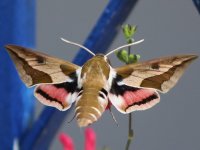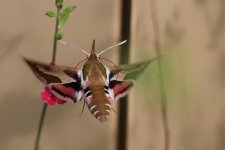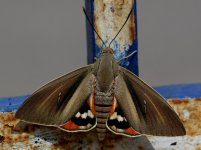Thank you Andy
I agree its not H. dahlii I had thought the thorax markings would identify the moth as this photo I now realise the extra black spots are missing as herein the first photo shown as stars The third photo shows its pink under colour
This french site was interesting
http://sphingidae-haxaire.com/index.php/macroglossinae-2/hyles-dahlii/
Quote in English
I was notified in January 2007 of the first catch in continental France of this species, carried out in the area of Jujols, in the Eastern Pyrenees (66) at the end of 2006. In the book Guide of the nocturnal butterflies of France coordinated by Roland Robineau, Schmit (2007: 33) points out this beautiful Hyles from continental France , obviously without controlling the copy quoted.
Thinking that it would be interesting to monitor the possible implantation and progression of the species in our territory, I decided to go to the exact place of this capture. The discoverer, Thierry Varenne, had the kindness to take to me to the same place He also sent me a up and under sided photograph of the individual in question, mentioning that he had observed 3 or 4 the same night. Careful observation of this cliché made me come to the conclusion that it is not Hyles dahlii but a very dark (and somewhat aberrant) copy of Hyles euphorbiae . This specimen does not have the two characters that diagnose H. dahlii, namely the bright pink underside, and especially the two supernumerary black spots on the top of the abdomen. Tony Pittaway and Ian Kitching kindly looked at this shot and agreed. The species is therefore to be removed from the list of Sphingidae of continental France. However, in May 2015, I visited the site with my colleague Gary Saunders, where I had the opportunity to collect H. euphorbiae by the lamp. All my collected samples (6 males) fall within the range of variation of the species. Eggs harvested locally on Euphorbia serrata gave rise to equally typical H. euphorbiae . We have not reviewed the aberration collected by Thierry Varenne.
Looking at many moth sites H. dahlii is often shown without 6 black spots even the one above
As for " isn't migratory"neither is this second picture also in the garden its from Chile, Palm Moth Paysandisia archon another non migratory here is the Geranium Bronze










